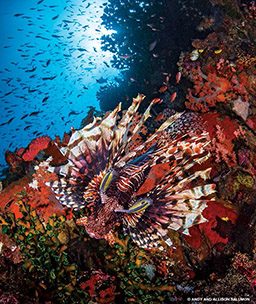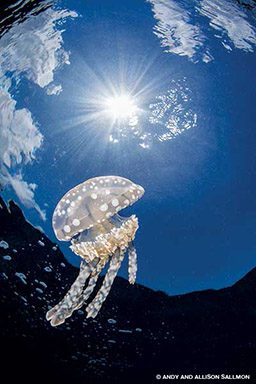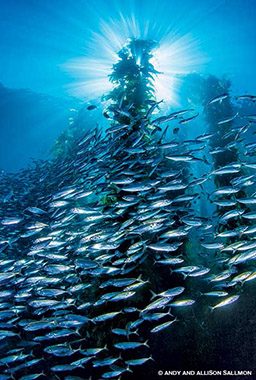
I was about to begin my ascent when I realized I was being watched. I glanced around, finally locating my observer 25 feet above me. A California sea lion blinked down at me from the water’s surface, his sleek shape perfectly outlined by the afternoon sun. Just as I was lifting my camera, the sea lion abruptly charged toward me, its mouth wide open.
I could hear the divers next to me cheering into their regulators as I depressed the shutter. The sea lion swam off, and I boarded the boat to exclamations of jealousy and demands to see my images. As I scrolled through the pictures, however, my heart sank. Instead of the shot I had envisioned — a defensive sea lion rimmed by strikingly defined sunrays — the image I had taken looked like a white ball of death rimmed by an ugly aqua halo. Was there even a sea lion in the middle of that blazing orb?
Instantly I knew what I had done wrong: My camera’s exposure settings, so perfect for the earlier images I’d taken with the sun at my back, hadn’t been adjusted to shoot into the sun. How humiliating. I turned to the other divers and shook my head sheepishly as their sympathetic laughs echoed around me. It turned out I was in good company; for the entire journey back to the harbor, the other shooters on board regaled me with similar tales of missed opportunities.
The Sunny Side of Digital Imaging
Open any book or magazine on diving, and the chances are excellent that you’ll find references to an photos of the sun. Rays filtering through the water, an incredible creature silhouetted by a sunburst, light piercing the entrance to a cavern: All are worthy of enthusiasm, and all have frustrated camera-toting divers. Finding and capturing those beautiful sunrays requires patience, effort and luck. Even if your camera settings are appropriate, clipped highlights, banding or general loss of detail could easily mar your photographs.
Film was better able to record contrast and subtle color detail than most digital sensors, so a properly exposed sunburst was more likely to yield a pleasing result. However, most photographers have long since transitioned to digital imaging, and we have learned to adjust from old to new media. Digital sensors are constantly improving, and digital cameras offer several tools to help photographers take full advantage of each opportunity.
Shooting images in RAW format ensures that we retain the maximum dynamic range for each image file. Reviewing images and histograms throughout each dive provides constant opportunities to adjust exposure settings, and bracketing (shooting several slightly different exposures of the same subject) provides a digital safety net to lessen the chances of exposure mishaps.
Sunrays and Sunbursts

If you have ever spent an extended safety stop mesmerized by the effects of late-afternoon sun as it strikes shallow water, you are familiar with shallow sunrays — also commonly called “God’s rays” or dappled light. Water is far denser than air, so while some of the sun’s light energy is reflected at the water-air interface, the rays that penetrate the water are refracted and scattered. Depending on the time of day and surface conditions, we can actually see defined, golden beams of light in the water column.
Although the optical explanation seems simple, this beautiful light effect requires a very particular set of circumstances that aren’t encountered on every dive. First, the deeper you go, the more light energy is diffused, so the “beam” effect mainly occurs in shallow water. Second, if there is a chop on the water’s surface, the sunlight will be more scattered, which may prevent the formation of distinct beams. Third, particulate in the water column, a nuisance in many other imaging situations, actually help define the sunrays. Finally, timing plays an enormous role in capturing this effect. This phenomenon is most likely when the sun is low in the sky; therefore some photographers may plan early-morning or late-afternoon dives to attempt to capture the effect.
Many of the principles for viewing and photographing sunbursts with defined rays are the same as for shallow sunrays. The key factors include shallow water containing some particulate matter, calm surfaces and a low-hanging sun. Deeper water or different times of day can present a sunball with different visual characteristics but that’s no less compelling of a compositional element.
Setting Yourself Up for Sunray Success
Whether shooting sunrays or sunballs, you’ll probably need to limit the amount of light that reaches your sensor. The most powerful tool in your camera to prevent the sunball from looking more like a sunblotch is shutter speed. If you’re using strobes, set your shutter to the fastest speed that permits strobe synchronization (1/160 sec to 1/320 sec for most cameras). If your image still looks overexposed and your ISO is as low as possible (100 for most cameras), then try decreasing the size of your aperture to reduce the size of the sunball. Note that ISO and aperture adjustment will also affect your foreground — a complicated issue addressed later in more detail.

A common tactic to compensate for a bright sun is extreme underexposure. While this approach will help dampen the brightness of your sunball and can result in striking, high-contrast images, it sometimes does so at the expense of capturing the true color of the water, rendering rich blue or green hues nearly black at the periphery of the frame.
Unfortunately, there are some occasions when shooting toward the sun simply will not produce an acceptable image. In very clear, shallow water at mid-day, for example, the chances are that your sunball will look like a whitish blob rimmed in thick cyan and aqua halos — no matter what camera settings you’ve chosen. A popular troubleshooting technique is to use reef or wreck structures, marine life or silhouetted divers to block the majority of the sun. Another option is to adjust your composition to include only the edge of the sun or its rays. One final option can be applied postdive: If you have taken a shot that inadvertently or unavoidably contains an overexposed sunball, a bit of creative cropping may allow you to rescue an otherwise unsalvageable image.
If you are over deep, clear water, there is an additional way to incorporate the sun into your image in very bright conditions: Shoot at a downward angle with the sun behind you. The rays will sometimes appear to converge to a point below you, creating an optical perspective effect that can add creative components to images, particularly pelagic marine life portraits. Since you’re not shooting toward the sun, this technique is more forgiving in terms of settings, although fast shutter speeds may still be necessary to freeze the light beams and capture sharp images of your primary subjects.
Cathedral Light
With photography, there are confusing exceptions to the rules. Cathedral light refers to the focused beams of sunlight that you can see within shipwrecks and caverns or adjacent to overhanging marine or plant life. Because this effect is viewed against dark or shadowed backdrops, demarcated rays are visible in relatively deeper water. Also, because these rays are viewed when the sun penetrates the crevices of the backdrop structure, they require a bright sun at a specific angle. Mid-day might be the best time to capture the effect in a kelp forest, but a cave opening facing east might work best in the morning light.
Since the backdrop in most of these scenarios is dark, your approach to exposure may be quite different than for shooting sunrays during shallow reef dives. A fast shutter speed will help to freeze the light beams, but if it’s too fast your image won’t show the detail of the surrounding structure. In this case, a bit of experimentation will help fine-tune the balance between sharp sunrays, detail and visible open-water colors. Metering the light of the open water and adjusting your settings accordingly can provide a good starting point. Or you can simply bracket. A digital LCD screen will reveal a good approximate starting point, and exposures with apertures above and below that are good insurance to ensure an optimal RAW image.

Foreground Forethought

When you incorporate strobe-lit foreground subjects, shooting toward the sun can get very tricky. We’ve mentioned that in extremely bright conditions it’s often necessary to adjust camera settings to limit the amount of light reaching your camera’s sensor. Increasing shutter speed is one way to decrease background exposure, but when you are shooting with a strobe illuminating foreground subjects, your adjustments are limited by the top synchronization speed of your camera. Once you begin decreasing your ISO or aperture size, assuming your strobe light to be constant, you are also decreasing the exposure of your foreground subject. When you alter either of these settings for ambient light, you should simultaneously adjust your strobe output accordingly, either by means of the strobe’s power settings or the strobe-to-subject distance.
For ISO a good starting point is to double your strobe power each time you halve your ISO; i.e., if you are shooting at ISO 200 with your strobes at ¼ power, then decreasing your ISO to 100 should prompt you to increase your strobes to ½ power. No doubt, this thought process relies upon a basic understanding of the interrelationship between ISO, aperture and strobe power, but your skill at this technique will be accelerated using a trial-and-error approach that incorporates careful review of images and histograms throughout your dive.
Even the most powerful strobes produce a finite amount of light that is puny compared to the sun. If you cannot adequately light your foreground subject, you might have to adjust your expectations more rigorously than your camera settings. Selecting smaller subjects, for instance, such as individual branches of soft coral as opposed to coral-covered bommies, will allow you to get closer, which will increase the potential light intensity on your subject. Light-colored or reflective subjects also require less strobe power than dark-colored or absorptive subjects.
If all else fails, one creative trick remains: the silhouette. By using an unlit subject to block the sun, you can singlehandedly mitigate the limitations of strobe synchronization speed — and potentially inadequately exposed foregrounds. For silhouettes it’s best to choose subjects with distinguishable shapes, such as divers or large, iconic marine life. With luck, the silhouette becomes a critical compositional element, allowing you to take full advantage of the sun’s rays.
© Alert Diver — Q4 Fall 2014